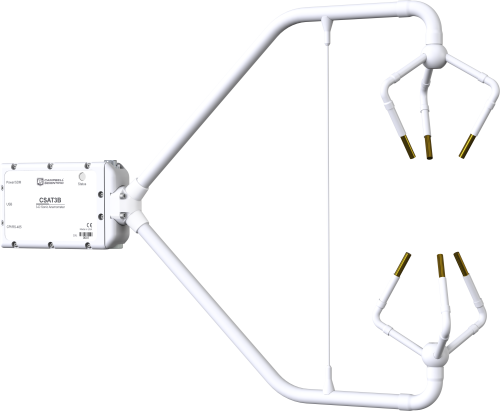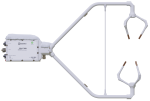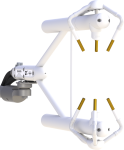
Designed for flux and other turbulence research projects






Overview
Campbell Scientific’s CSAT3B 3-D Sonic Anemometer is an update and replacement to the original CSAT3, and remains the 3-D sonic anemometer of choice for eddy-covariance measurements. It has an aerodynamic design, a 10 cm vertical measurement path, operates in a pulsed acoustic mode, and withstands exposure to harsh weather conditions. Three orthogonal wind components (ux, uy, uz) and the sonic temperature (Ts) are measured and output at a maximum rate of 100 Hz.
The most conspicuous innovation of the new design is the elimination of the electronics box. Instead, the electronics are packaged inside the mounting block of the CSAT3B head. This design feature makes installation easier and offers greater flexibility in instrument placement.
Measurements can be triggered from three sources:
- Data logger SDM command
- Data logger CPI command
- CSAT3B internal clock
The SDM and CPI protocols both support mechanisms for synchronizing multiple CSAT3Bs.
Benefits and Features
- New conformal coating helps protect sonic transducers in corrosive environments
- Integrated electronics that provide easy mounting of a single piece of hardware
- Integrated inclinometer
- High-precision measurements ideal for turbulence and eddy-covariance studies
- An improved design with a thin, aerodynamic support strut close to the ends of the sensor arms, creating greater rigidity and improved accuracy of sonic temperature
- Data logger sampling supported for any frequency between 1 and 100 Hz
- New CPI communications for more robust, higher bandwidth measurements
- Multiple communication options including SDM, CPI, USB, and RS-485
- Internal temperature and humidity measurements with easily replaced desiccant
- Version 5 algorithm for calculating data outputs; combines the signal sensitivity of version 3 with the rain performance of version 4
- Includes options to filter high frequencies for applications requiring analysis of non-aliased spectra
Images



3D/CAD Files:
Videos & Tutorials
Compatibility
Please note: The following shows notable compatibility information. It is not a comprehensive list of all compatible products.
Dataloggers
| Product | Compatible | Note |
|---|---|---|
| CR1000 (retired) | ||
| CR1000X (retired) | ||
| CR300 (retired) | ||
| CR3000 (retired) | ||
| CR310 | ||
| CR350 | ||
| CR6 | ||
| CR800 (retired) | ||
| CR850 (retired) | ||
| CR850 (retired) | ||
| CR850 (retired) | ||
| CR850 (retired) |
Additional Compatibility Information
The CSAT3B works with standard USB ports on most computers. However, for consistent communications—especially when using multiple USB devices or lower-powered ports (such as those on laptops or hubs without power)—we recommend using a powered USB hub for optimal performance.
Specifications
| Sensor | 3-dimensional sonic anemometer |
| Measurement Description | Highest-quality wind speed and direction |
| Operating Temperature Range | -40 to +50°C (equivalent to 305 to 368 m s-1 in speed of sound) |
| Outputs | ux, uy, uz, Ts (ux, uy, uz are wind components referenced to the anemometer axes; Ts is sonic temperature in degrees Celsius.) |
| Signal Type/Output | SDM, CPI, USB, RS-485 |
| Speed of Sound | Determined from three acoustic paths. (Corrected for crosswind effects.) |
| Wind Direction Range | 2.5 to 357.5° in CSAT3B coordinate system (0 to 360° customized) |
| Range | ± 65 m s–1 (full-scale wind) |
| Filter Bandwidths | 5, 10, or 25 Hz |
| Measurement Path Length | 10.0 cm (3.9 in.) vertical; 5.8 cm (2.3 in.) horizontal |
| Transducer Angle from Horizontal | 60 degrees |
| Transducer Diameter | 0.64 cm (0.25 in.) |
| Transducer Mounting Arm Diameter | 0.84 cm (0.33 in.) |
| Support Arm Diameter | 1.59 cm (0.63 in.) |
| Anemometer Head Weight | 1.45 kg (3.2 lb) |
| Anemometer Dimensions | 60.64 x 12.2 x 43.0 cm (23.87 x 4.8 x 16.9 in.) |
Wind Accuracy |
|
| -NOTE- |
Accuracy specifications assume the following:
|
| Maximum Offset Error | < ±8.0 cm s-1 (ux, uy), < ±4.0 cm s-1 (uz) |
| Maximum Gain Error |
|
Measurement Resolution |
|
| ux, uy | 1 mm s-1 rms |
| uz | 0.5 mm s-1 rms |
| Ts | 0.002°C RMS (at 25°C) |
| Wind Direction | < 0.058° (ux = uy ≤ 1 m s-1) |
Measurement Rates |
|
| Data Logger Triggered | 1 to 100 Hz |
| Unprompted Output (to PC) | 10, 20, 50, or 100 Hz |
| Internal Self-Trigger Rate | 100 Hz |
Measurement Delay |
|
| Data Logger Triggered (no filter) | 1 trigger period (1 scan interval) |
| Unprompted Output (no filter) | 10 ms |
| Filtered Output (data-logger-prompted or unprompted to PC) |
|
Internal Monitor Measurements |
|
| Update Rate | 2 Hz |
| Inclinometer Accuracy | ±1° |
| Relative Humidity Accuracy |
|
| Board Temperature Accuracy | ±2°C |
SDM |
|
| -NOTE- | Used for data-logger-based data acquisition. |
| Bit Period | 10 µs to 1 ms |
| Cable Length |
|
| Address Range | 1 to 14 |
| Bus Clocks per Sample | ~200 |
CPI |
|
| -NOTE- | Used for data-logger-based data acquisition. |
| Baud Rate | 50 kbps to 1 Mbps |
| Cable Length |
|
| Address Range | 1 to 120 |
| Bus Clocks per Sample | ~300 |
RS-485 |
|
| -NOTE- | Used for configuration or PC-based data acquisition. |
| Baud Rate | 9.6 kbps to 115.2 kbps |
| Cable Length |
|
| Bus Clocks per Sample | ~500 (ASCII formatted) |
USB |
|
| -NOTE- | Used for configuration or PC-based data acquisition. |
| Connection Speed | USB 2.0 full speed 12 Mbps |
| Cable Length | 5 m (16.4 ft) maximum |
Power Requirements |
|
| Voltage Supply | 9.5 to 32 Vdc |
| Current at 10 Hz Measurement Rate |
|
| Current at 100 Hz Measurement Rate |
|
Related Documents
Downloads
CSAT3B Example Programs v.1 (4 kB) 20-10-2020
Three example programs.
Simple SDM Program: SDM communications are used to collect data from a single CSAT3B.
Simple CPI Program: CPI communications are used to collect data from a single CSAT3B.
Advanced CPI Program: A single CSAT3B is properly configured and CPI communications are used to collect the data.
CPI Calculator v.1.0 (2.49 MB) 06-07-2016
The CPI Calculator is a downloadable Microsoft Excel spreadsheet used to estimate the usage and capacity of a CPI network. The calculator provides an overview on CPI devices including the CDM-A108, CDM-A116, CDM-VW300, CDM-VW305, and the CSAT3B. The calculator can also estimate the measurement speed of the CDM-A108 and CDM-A116 based on the number of channels and measurement parameters.
The CPI Calculator is an estimation tool and will help you better understand and design CPI networks by considering the following:
- What is the capability of each CDM or CPI device
- What is the CPI network capacity
- How much of the CPI capacity are the CDMs or CPI devices using
Related FAQs
Number of FAQs related to CSAT3B: 2
-
The CSAT3B works with standard USB ports on most computers. However, for consistent communication—especially when using multiple USB devices or lower-powered ports (such as those on laptops or hubs without power)—we recommend using a powered USB hub for optimal performance.
-
The CSAT3A, CSAT3AH, CSAT3B, and CSAT3BH have been optimized for most terrestrial applications. If the sonic anemometer is to be used in a marine environment or in an environment where it is exposed to corrosive chemicals (for example, sulfur-containing compounds in viticulture), expect the sonic transducers to age more quickly and require replacement sooner than a unit deployed in an inland, chemical-free environment. Campbell Scientific offers a conformal coating option with our sonics to help alleviate corrosion; if your application poses a corrosive risk, consider adding this coating to your transducers. If possible, mount the sonic anemometer in a way that reduces exposure to saltwater spray/splash and/or corrosive chemicals. For applications that experience frozen precipitation, the heated versions of the CSAT3A and CSAT3B may be better suited.
Case Studies
Overview In the heart of the UAE’s Empty Quarter desert—one of the harshest and least hospitable......read more




